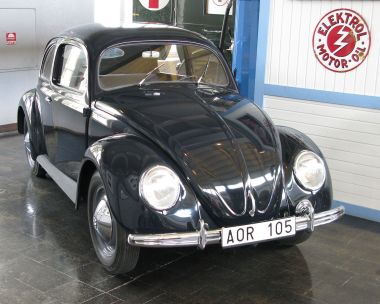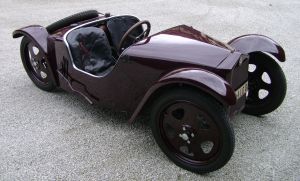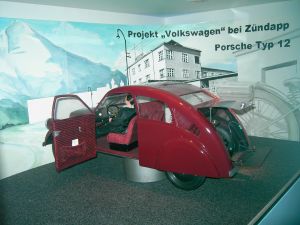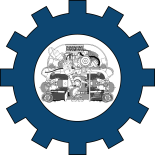Type 1: Difference between revisions
WestyMan1971 (talk | contribs) |
WestyMan1971 (talk | contribs) |
||
| Line 74: | Line 74: | ||
Upon Hitler's rise to power in 1933, the German auto industry was limited to luxury models, which few Germans could afford. Only one German out of 50 owned a car. The newly appointed chancellor began to form plans to utilize state resources to develop an affordable automobile. At the 1933 Berlin Auto Show, he viewed a presentation of the Standard Superior by Josef Ganz. Hitler was quite impressed with the revolutionary design and low price of the Superior. Ganz, however, was arrested by the Gestapo shortly thereafter on falsified charges of blackmailing the German automotive industry. Ganz was eventually released and quickly fled Germany. | Upon Hitler's rise to power in 1933, the German auto industry was limited to luxury models, which few Germans could afford. Only one German out of 50 owned a car. The newly appointed chancellor began to form plans to utilize state resources to develop an affordable automobile. At the 1933 Berlin Auto Show, he viewed a presentation of the Standard Superior by Josef Ganz. Hitler was quite impressed with the revolutionary design and low price of the Superior. Ganz, however, was arrested by the Gestapo shortly thereafter on falsified charges of blackmailing the German automotive industry. Ganz was eventually released and quickly fled Germany. | ||
In May 1934, at a meeting at Berlin's Kaiserhof Hotel, Hitler outlined his request for a basic vehicle that could transport two adults and three children at 100 km/h while not using more than 7 litres of fuel per 100 km. The engine had to be powerful enough for sustained cruising on Germany's Autobahn, which was under construction at the time. Parts needed to be widely available and quickly and affordably exchanged. The engine had to be air-cooled to avoid radiators freezing during the winter months. This "People's Car" was to be made available to citizens of Germany through a stamp booklet savings plan, | In May 1934, at a meeting at Berlin's Kaiserhof Hotel, Hitler outlined his request for a basic vehicle that could transport two adults and three children at 100 km/h while not using more than 7 litres of fuel per 100 km. The engine had to be powerful enough for sustained cruising on Germany's Autobahn, which was under construction at the time. Parts needed to be widely available and quickly and affordably exchanged. The engine had to be air-cooled to avoid radiators freezing during the winter months. It's platform must be easily adapted to a variety of uses, including military applications. This "People's Car" was to be made available to citizens of Germany through a stamp booklet savings plan, for under 1000 Reichsmarks. (At the time, the average weekly income was around 32 Reichsmarks.) | ||
= Design timeline = | = Design timeline = | ||
Revision as of 23:31, 7 August 2023
| Beetle | |
|---|---|
 1949 Beetle Type 11 (Export Model) | |
| Overview | |
| Manufacturer | Volkswagen |
| Also called | |
| Production | 1938–2003: 21,529,464 built |
| Designer | Ferdinand Porsche |
| Variants | |
| Derivatives |
|
| Powertrain | |
| Engine | |
| Transmission |
|
| Dimensions | |
| Wheelbase | 2,400 mm (94.5 in) |
The Beetle—officially the Type 1, is an economy car that was manufactured and marketed by Volkswagen (VW) from 1938 until 2003.
It was designed by Ferdinand Porsche and features an air cooled rear-engine, two door coupe or cabriolet body-on-chassis design.
History
Josef Ganz's "Maikäfer" and the Standard Superior

The idea of a "people's car" can traced as far back as 1923, when a young Jewish Hungarian engineering student named Josef Ganz began sketching concepts for a "car for the masses." Ganz's design featured a mid-mounted engine, independent suspension and a streamlined body.
Being a student, Ganz did not have the funding to produce a prototype of his design, but instead began submitting articles on automotive design for various publications. Shortly after completing his studies in 1927, Ganz was hired as editor-in-chief of Klein-Motor-Sport (later renamed Motor-Kritik), where he continued to write articles promoting progressive design and the creation of a car for the average citizen.
In 1929, Josef Ganz contacted motorcycle manufacturers Zündapp, Ardie and DKW with assistance to build a prototype of his concept. The first prototype, the Ardie-Ganz, was built at Ardie in 1930 and a second one was completed at Adler in 1931, which was nicknamed the Maikäfer (‘May-Beetle').
Production of the first car based on Josef Ganz's designs and patents began in 1933. The Standard Superior, built by Standard Fahrzeugfabrik, featured a body-on-tubular chassis, 2-stroke air cooled mid-engine, and independent suspension with rear swing-axles. This car was advertised as the German "Volkswagen," or "people's car," pre-dating the incorporation of Volkswagenwerk GmbH in 1937. Superior production ceased in 1935.
Due to the antisemitic policies of the Nazi Party, Ganz's influence on the development of the Beetle was largely forgotten and has often been left out of official Volkswagen history. His contribution is still widely debated to this day.
Ferdinand Porsche's prototypes

In 1931, Zündapp requested Austrian engineer Ferdinand Porsche design and build a prototype for an "everyman's automobile." This led to the development of three prototypes (two saloons and one coupe) known as the Porsche Type 12. These prototypes features a U-channel center beam chassis, leaf spring suspension, worm-gear steering and hydraulic drum brakes. The drivetrain consisted of a Zündapp-built five-cylinder radial engine (as opposed to Porsche's preferred flat-four engine) and a combined gearbox differential transmission joined by a wet single disc clutch. The Type 12 laid the basic design foundation for what would eventually become the Beetle.
In 1932, Porsche was contacted by NSU Motorenwerke to design and build a prototype automobile. NSU wished to return to manufacturing cars after a period of exclusively building motorcycles. While Zündapp has requested use of their radial engine, NSU placed no such restrictions and gave Porsche full control of development. This resulted in the construction of three prototypes, with two different body styles, called the Type 32. These prototypes featured the rear air-cooled flat-four engine, central tube frame, front axle, rear swing axle and torsion bar suspension that would become quite familiar to Volkswagen owners in the subsequent decades.
Adolf Hitler and the KdF Wagen
In 1924, a young Adolf Hitler spent nine months in Landsberg Prison as a result of his Nazi Party's failed coup the year prior. While serving his sentence, Hitler read several books about Henry Ford's development of mass production techniques. The future chancellor came to admire Ford and made it among his political ambitions to bring affordable transportation to the people of Germany in the same manner which Ford had done in the United States.
Upon Hitler's rise to power in 1933, the German auto industry was limited to luxury models, which few Germans could afford. Only one German out of 50 owned a car. The newly appointed chancellor began to form plans to utilize state resources to develop an affordable automobile. At the 1933 Berlin Auto Show, he viewed a presentation of the Standard Superior by Josef Ganz. Hitler was quite impressed with the revolutionary design and low price of the Superior. Ganz, however, was arrested by the Gestapo shortly thereafter on falsified charges of blackmailing the German automotive industry. Ganz was eventually released and quickly fled Germany.
In May 1934, at a meeting at Berlin's Kaiserhof Hotel, Hitler outlined his request for a basic vehicle that could transport two adults and three children at 100 km/h while not using more than 7 litres of fuel per 100 km. The engine had to be powerful enough for sustained cruising on Germany's Autobahn, which was under construction at the time. Parts needed to be widely available and quickly and affordably exchanged. The engine had to be air-cooled to avoid radiators freezing during the winter months. It's platform must be easily adapted to a variety of uses, including military applications. This "People's Car" was to be made available to citizens of Germany through a stamp booklet savings plan, for under 1000 Reichsmarks. (At the time, the average weekly income was around 32 Reichsmarks.)
